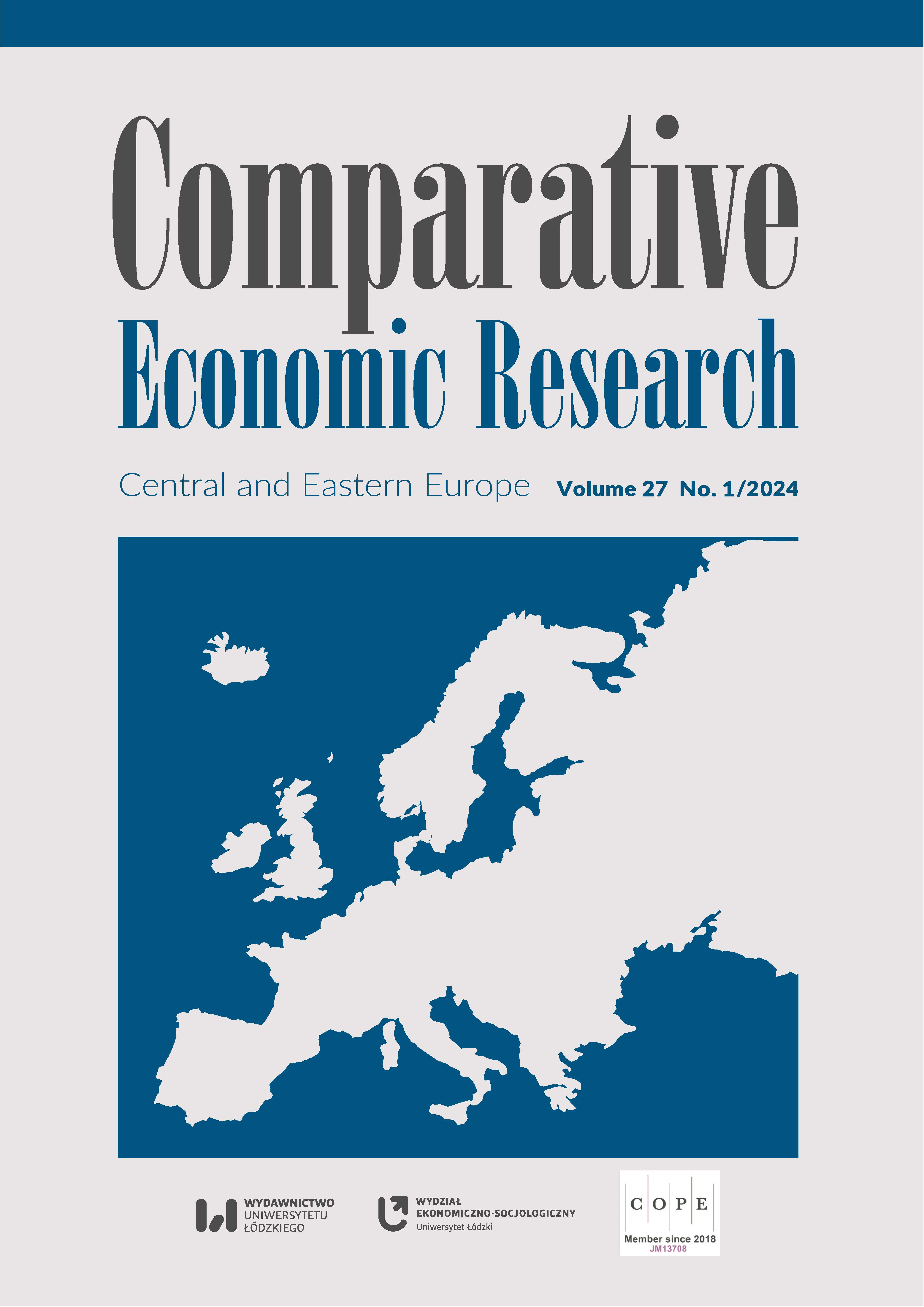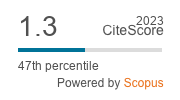The Interactions between Labour Market Policies and Income Inequalities in Groups of European Union Countries
DOI:
https://doi.org/10.18778/1508-2008.27.09Keywords:
income inequalities, labour market policy, sustainable labour market, social cohesion, sustainable developmentAbstract
Social cohesion and a sustainable labour market remain the aims of sustainable development policy. However, income inequalities and labour market policies are more often separately analysed. To fill the identified research gap, our article presents the results of an analysis of interactions between active and passive labour market policies and income inequalities in the European Union. The 27 countries were divided into two clusters based on their active and passive labour market policy (LMP) expenditures in 2019. These clusters sustain the basis for analysing the interactions between LMP and income inequalities in its different measures. The results reveal that labour market interventions interact with income inequalities, decreasing disposable income inequalities (equalising the disposable income after transfers and taxes) and therefore contributing to social cohesion. This paper concerns social cohesion as the manifestation of intragenerational justice.
Downloads
References
Adsera, A., Boix, C. (2000), Must we choose? European unemployment, American inequality, and the impact of education and labor market institutions, “European Journal of Political Economy”, 16 (4), pp. 611–638, https://doi.org/10.1016/S0176-2680(00)00019-7
Google Scholar
DOI: https://doi.org/10.1016/S0176-2680(00)00019-7
Amadeo, E.J., Pero, V. (2000), Adjustment, stabilisation and the structure of employment in Brazil, “The Journal of Development Studies”, 36 (4), pp. 20–148, https://doi.org/10.1080/00220380008422640
Google Scholar
DOI: https://doi.org/10.1080/00220380008422640
Atkinson, A. (1996), Seeking to explain the distribution of income, [in:] J. Hills (ed.), New inequalities: the changing distributions of income and wealth in the United Kingdom, Cambridge University Press, Cambridge–New York, pp. 19–48, https://doi.org/10.1017/CBO9780511521935.002
Google Scholar
DOI: https://doi.org/10.1017/CBO9780511521935.002
Berg, J. (ed.) (2015), Labour Markets, Institutions and Inequality. Buiding Just Societies in the 21st Century, Edward Elgar Publishing, Cheltenham–Northamption–Geneva, https://doi.org/10.4337/9781784712105
Google Scholar
DOI: https://doi.org/10.4337/9781784712105
Betcherman, G. (2012), Labor market institutions: A review of the literature, “World Bank Policy Research Working Paper”, 6276.
Google Scholar
DOI: https://doi.org/10.1596/1813-9450-6276
Bijnen, E.J. (1973), Cluster analysis. Survey and evaluation of techniques, Springer, Dordrecht, https://doi.org/10.1007/978-94-011-6782-6
Google Scholar
DOI: https://doi.org/10.1007/978-94-011-6782-6
Burniaux, J., Padrini, F., Brandt, N. (2006), Labour Market Performance, Income Inequality and poverty in OECD countries, “OECD Economic Department Working Papers”, 500, OECD, Paris.
Google Scholar
Castellano, R., Musella, G., Punzo, G. (2017), Structure of the labour market and wage inequality: evidence from European countries, “Quality & Quantity – International Journal of Methodology”, 51 (5), pp. 2191–2218, https://doi.org/10.1007/s11135-016-0381-7
Google Scholar
DOI: https://doi.org/10.1007/s11135-016-0381-7
Checchi, D., García Peñalosa, C. (2008), Labour market institutions and income inequality, “LIS Working Paper Series”, 470, Luxembourg Income Study, Luxembourg, https://doi.org/10.1111/j.1468-0327.2008.00209.x
Google Scholar
DOI: https://doi.org/10.1111/j.1468-0327.2008.00209.x
Checchi, D., Garcia Peñalosa, C. (2010), Labour Market Institutions and the Personal Distribution of Income in OECD Countries, “IZA Discussion Paper”, 1681.
Google Scholar
DOI: https://doi.org/10.1111/j.1468-0335.2009.00776.x
Easterly, W. (2007), Inequality does cause underdevelopment: Insights from a new instrument, “Journal of Development Economics”, 84 (2), pp. 755–776, https://doi.org/10.1016/j.jdeveco.2006.11.002
Google Scholar
DOI: https://doi.org/10.1016/j.jdeveco.2006.11.002
European Commission (2010), Europe 2020: a strategy for smart, sustainable and inclusive growth, COM (2020) final.
Google Scholar
European Commission (2017a), European Semester: Thematic factsheet – Active labour market policies, https://commission.europa.eu/content/thematic-factsheets/labour-markets-and-skills_en (accessed: 10.01.2022).
Google Scholar
European Commission (2017b), European Semester: Thematic factsheet – Unemployment benefits, https://commission.europa.eu/content/thematic-factsheets/labour-markets-and-skills_en (accessed: 10.01.2022).
Google Scholar
European Commission (2020), Employment and Social Developments in Europe, https://ec.europa.eu/social/main.jsp?catId=738&langId=en&pubId=8342&furtherPubs=yes (accessed: 20.01.2022).
Google Scholar
Eurostat (2021), Labour market policy (source: DG EMPL) (lmp), https://ec.europa.eu/employment_social/employment_analysis/lmp/lmp_esms.htm (accessed: 22.11.2021).
Google Scholar
Eurostat (2022a), LMP expenditure, online data codes: LMP_IND_EXP, https://webgate.ec.europa.eu/empl/redisstat/databrowser/view/LMP_IND_EXP/default/table (accessed: 10.01.2022).
Google Scholar
Eurostat (2022b), Data Browser, https://ec.europa.eu/eurostat/databrowser/view/ILC_DI11/default/table?lang=en&category=livcon.ilc.ilc_ie.ilc_iei (accessed: 2.02.2022).
Google Scholar
Everitt, B., Landau, S., Leese, M., Stahl, D. (2011), Cluster analysis, Wiley, Chichester, https://doi.org/10.1002/9780470977811
Google Scholar
DOI: https://doi.org/10.1002/9780470977811
Han, J., Kamber, M., Pei, J. (2012), Data Mining: Concepts and Techniques, Elsevier, Amsterdam.
Google Scholar
Hennig, C., Meila, M., Murtagh, F., Rocci, R. (2015), Handbook of Cluster Analysis, Chapman and Hall, New York, https://doi.org/10.1201/b19706
Google Scholar
DOI: https://doi.org/10.1201/b19706
IBM documentation (2022), Hierarchical Cluster Analysis Method, https://www.ibm.com/docs/en/spss-statistics/28.0.0?topic=analysis hierarchical cluster method (accessed: 15.12.2021).
Google Scholar
Ilostat (2022), Labour income distribution, https://ilostat.ilo.org/data/ (accessed: 2.02.2022).
Google Scholar
International Labour Organization (2012), The strategy of the International Labour Organization Social security for all. Building social protection floors and comprehensive social security systems, International Labour Office, Social Security Department, Geneva.
Google Scholar
International Labour Organization (2021), World Social Protection Report 2020–22: Social protection at the crossroads – in pursuit of a better future, International Labour Office, Geneva.
Google Scholar
Kaufmann, L., Rousseeuw, P.J. (2005), Finding Groups in Data: An Introduction to Cluster Analysis, Wiley Series in Probability and Statistics, Hoboken.
Google Scholar
Koeniger, W., Leonardi, M., Nunziata, L. (2004), Labour Market Institutions and Wage Inequality, “IZA Discussion Paper”, 1291, https://doi.org/10.2139/ssrn.588141
Google Scholar
DOI: https://doi.org/10.2139/ssrn.588141
Lubk, C. (2016), Sustainability and Labor, [in:] C. Lubk, The Concept of Sustainability and Its Application to Labor Market Policy. A Discussion of Political Feasibility, Implementation, and Measurability, Springer, Germany, pp. 107–130, https://doi.org/10.1007/978-3-658-16383-9_4
Google Scholar
DOI: https://doi.org/10.1007/978-3-658-16383-9_4
Murtagh, F., Legendre, P. (2011), Ward’s Hierarchical Clustering Method: Clustering Criterion and Agglomerative Algorithm, “Journal of Classification”, 31 (3), pp. 274–295, https://doi.org/10.1007/s00357-014-9161-z
Google Scholar
DOI: https://doi.org/10.1007/s00357-014-9161-z
OECD (2012), Inequality in labour income – What are its drivers and how can it be reduced?, “OECD Economics Department Policy Notes”, 8.
Google Scholar
OECD (2015), In It Together: Why Less Inequality Benefits All?, OECD Publishing, Paris, https://doi.org/10.1787/9789264235120-en
Google Scholar
DOI: https://doi.org/10.1787/9789264235120-en
OECD (2017), Labour market structure and wages: policies to reduce inequality in OECD countries, Jobs and Incomes Division, United Nations, Expert meeting on policies to tackle inequality, https://www.un.org/development/desa/dspd/wp-content/uploads/sites/22/2018/06/celine-paper.pdf (accessed: 22.11.2021).
Google Scholar
OECD (2018), Methodological and operational issues encountered in OECD work with LMP data, https://www.oecd.org/els/emp/OECD-2018-Methodological%20and%20operational%20issues%20encountered%20in%20OECD%20work%20with%20LMP%20data%20FINAL.pdf (accessed: 10.01.2022).
Google Scholar
Offe, C. (2010), Inequality and the Labour Market – Theories, opinions, models, and practices of unequal distribution and how they can be justified, “Zeitschrift für Arbeitsmarkt, Forschung”, 43, pp. 39–52, https://doi.org/10.1007/s12651-010-0030-x
Google Scholar
DOI: https://doi.org/10.1007/s12651-010-0030-x
Romero, J.M., Kuddo, A. (2019), Moving forward with ALMPs: Active labor policy and the changing nature of labor markets, “Social Protection and Jobs, Discussion Paper”, 1936, https://doi.org/10.1596/33081
Google Scholar
DOI: https://doi.org/10.1596/33081
Sachs, J.P. (2012), From Millennium Development Goals to Sustainable Development Goals, “The Lancet”, 379 (9832), pp. 2206–2211, https://doi.org/10.1016/S0140-6736(12)60685-0
Google Scholar
DOI: https://doi.org/10.1016/S0140-6736(12)60685-0
Sakamoto, T. (2021), Do social investment policies reduce income inequality? An analysis of industrial countries, “Journal of European Social Policy”, 31 (4), https://doi.org/10.1177/09589287211018146
Google Scholar
DOI: https://doi.org/10.1177/09589287211018146
Szczepaniak, M. (2020), Redistribution and the alleviation of income inequalities: the case of the European Union, “Economics and Law”, 19 (1), pp. 149–161, https://doi.org/10.12775/EiP.2020.011
Google Scholar
DOI: https://doi.org/10.12775/EiP.2020.011
Szczepaniak, M. Szulc Obłoza, A. (2019), Labour market institutions and income inequalities across the European Union, “Economics and Law”, 18 (3), pp. 365–377, https://doi.org/10.12775/EiP.2019.025
Google Scholar
DOI: https://doi.org/10.12775/EiP.2019.025
Taubner, H., Tideman, M., Nyman C.S. (2021), Employment Sustainability for People with Intellectual Disability: A Systematic Review, “Journal of Occupational Rehabilitation”, 32, pp. 353–364, https://doi.org/10.1007/s10926-021-10020-9
Google Scholar
DOI: https://doi.org/10.1007/s10926-021-10020-9
Thevenot, C. (2018), Labour market structure and wages: policies to reduce inequality in OECD countries, Jobs and Income Division United Nations, Expert meeting on policies to tackle inequality, June, https://www.un.org/development/desa/dspd/wp-content/uploads/sites/22/2018/06/7-2.pdf (accessed: 20.11.2021).
Google Scholar
Tuffery, S. (2011), Data Mining and Statistics for Decision Making, Wiley, Chichester, https://doi.org/10.1002/9780470979174
Google Scholar
DOI: https://doi.org/10.1002/9780470979174
Ward, J.H. (1963), Hierarchical Grouping to Optimise an Objective Function, “Journal of the American Statistical Association”, 301 (58), https://doi.org/10.1080/01621459.1963.10500845
Google Scholar
DOI: https://doi.org/10.2307/2282967
Downloads
Published
How to Cite
Issue
Section
License

This work is licensed under a Creative Commons Attribution-NonCommercial-NoDerivatives 4.0 International License.











